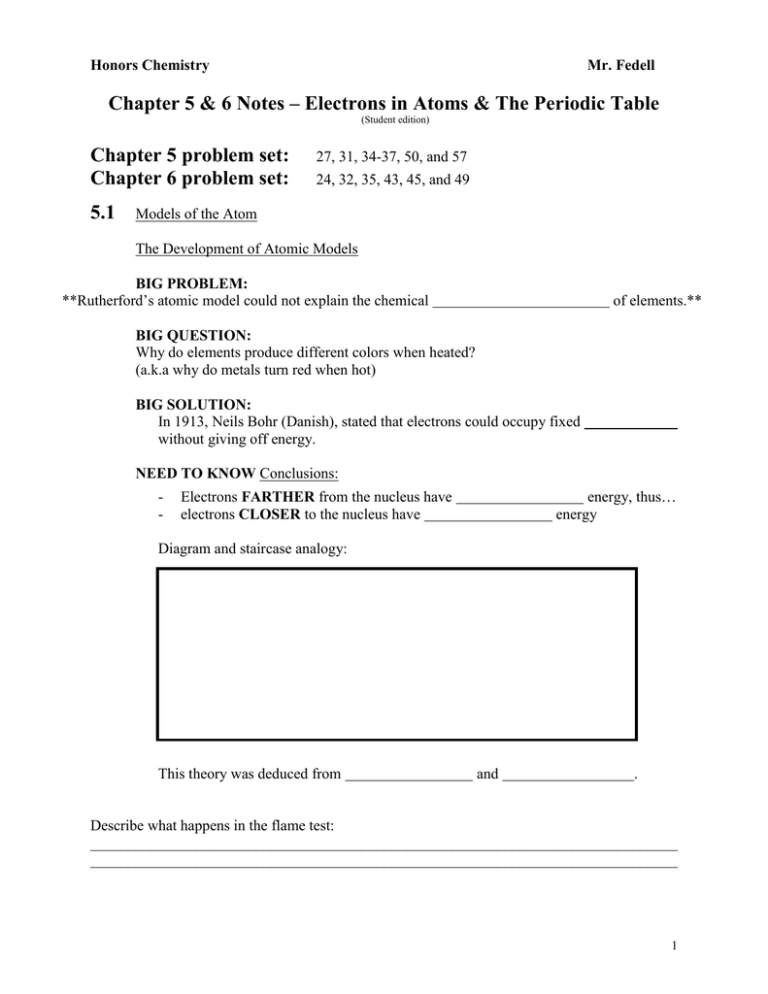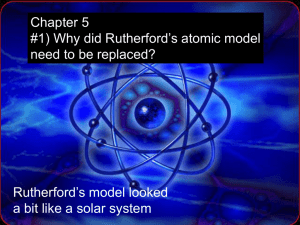Honors Chemistry
advertisement

Honors Chemistry Mr. Fedell Chapter 5 & 6 Notes – Electrons in Atoms & The Periodic Table (Student edition) Chapter 5 problem set: Chapter 6 problem set: 5.1 27, 31, 34-37, 50, and 57 24, 32, 35, 43, 45, and 49 Models of the Atom The Development of Atomic Models BIG PROBLEM: **Rutherford’s atomic model could not explain the chemical of elements.** BIG QUESTION: Why do elements produce different colors when heated? (a.k.a why do metals turn red when hot) BIG SOLUTION: In 1913, Neils Bohr (Danish), stated that electrons could occupy fixed without giving off energy. NEED TO KNOW Conclusions: - energy, thus… energy Electrons FARTHER from the nucleus have electrons CLOSER to the nucleus have Diagram and staircase analogy: This theory was deduced from and . Describe what happens in the flame test: ______________________________________________________________________________ ______________________________________________________________________________ 1 Draw a gas tube: 5.3 Physics and the Quantum Mechanical Model So… Why DO elements produce when ? NEED TO KNOW: Bohr’s answer **Since the amount of energy an electron has determines the distance it orbits from the nucleus, the electrons:** 1. energy (heat, electricity, or light) and move to higher energy levels ( from the nucleus). 2. the extra energy as and to a energy level. WE SAY: “Electrons take in energy, jump up, fall back down, and release energy in the form of light.” Examples: ___________________________________________________________________. 5.1 Continued . . . Models of the Atom Eventually, we learn that the Bohr model is a lie. Bohr model really is wave mechanical model Quantum mechanics (equations) allows scientists to determine the probability of finding particles in certain places. This leads to the quantum (wave) mechanical model. This model does not show the path of electrons - just the most location 2 6.1 Organizing the Elements and Classifying the Elements NEED TO KNOW HISTORY: Origin of the periodic table Dimitri Mendeleev - publish first real periodic table in 1869 - based on - listed elements in order of - left spaces for Property Eka - Aluminum Atomic Mass Density Melting Point Oxide Formula 68 amu 5.9 g/cm3 low E2O3 Ga (1875) NEED TO KNOW SKILL: Predicting properties using other elements data: Example: Predict the density of Aluminum given: Density: Ga = 5.9g/cm3 & B = 2.3 g/cm3 **FIND THE AVERAGE!!! NEED TO KNOW Modern Periodic Law: ** Properties of elements are a periodic function of atomic number. ** NEED TO KNOW INFO: Reading the periodic table: Periods: left to right on the periodic table elements have the same # of elements have similar properties a.k.a rows, shells, and energy levels Groups: up and down on the periodic table elements have the same # valence electrons elements have similar properties a.k.a families (columns) 3 NEED TO KNOW CLASSIFICATION: General Drawing of the Periodic Table: Metals, Metalloids, Nonmetals) NEED TO KNOW FAMILIES: Metalloids - B, Si, As, Te, At, Ge, Sb Group 18 – Noble Gases – Very UNreactive 5.2 & 6.3 Electron Arrangement in Atoms & Periodic Trends NEED TO KNOW PERIODIC TREND: Valence Electrons – electrons that occupy the H Be 1 2 Transition Metals (usually 2 VE) B 3 shell C 4 N 5 O 6 He F 7 8 NEED TO KNOW PERIODIC TREND: Electronegativity – the ability of an atom to attract electrons ( has highest value) Increasing trend looks like…. 4 Organizing Electrons on the PT: By Row and Sublevel NEED TO KNOW SKILL: Writing Orbital Notation Type S P D F number of sublevels __ __ __ __ total # of electrons 2 6 10 14 Notation for orbital notation Orbital Notation: a representation of the Example: _ 1s example - oxygen 1s 1= 2s of each electron = s= 2p NEED TO KNOW SKILL: Writing Electron Configuration Notation for electron configurations Electron Configuration: a representation of the arrangement of electrons in an atom. Example: 2p2 2 = Row p = sublevel 2 = # electrons in sublevel example - oxygen 1s22s22p4 5 Electron Notation: Electrons enter orbitals in a set pattern. For the most part, they follow the Aufbau Principle, the Pauli Exclusion Principle, and Hund’s Rule: NEED TO KNOW PRINCIPLES: Principle: electrons must fill energy levels before entering higher levels. Example: Why we fill s-orbitals (low energy) before p-orbitals (high energy) Pauli Exclusion Principle - electrons occupying the same orbital must have opposite spin. Example: Why we fill orbitals with an UP-arrow and DOWN-arrow Hund’s rule ( better known as the ): before any second electron can be placed in a sub level, all the orbitals of that sub level must contain at least one electron. Example: Why we do one UP-arrow in each orbital before placing a DOWN-arrow Practice: Orbital Notation: Draw the first 18 H He Electron Configuration: Draw the first 18 H He Li Be Li Be B C B C N N O O F F Ne Ne Na Na Mg Mg Al Al Si Si P P S S Cl Cl Ar Ar 6




